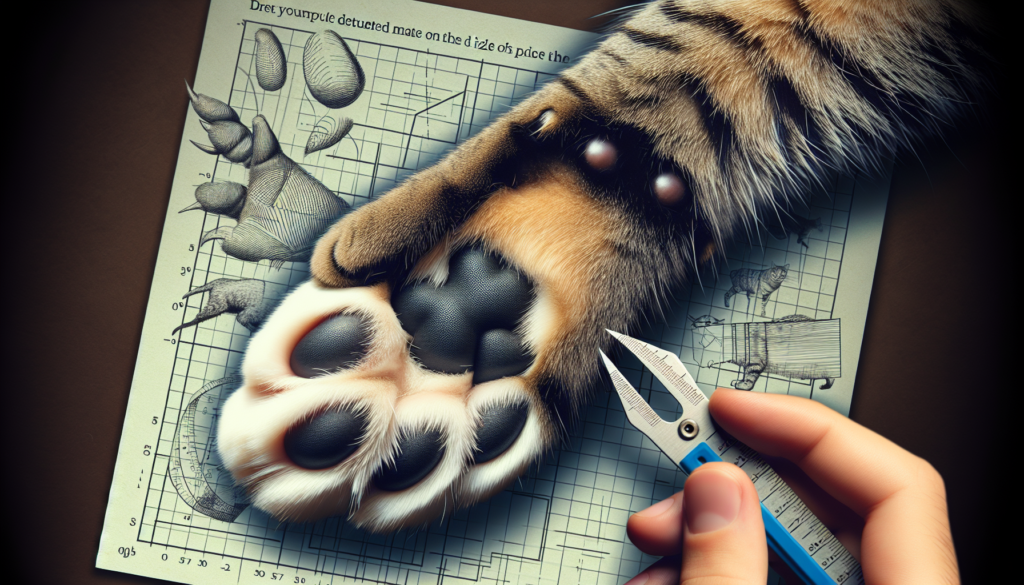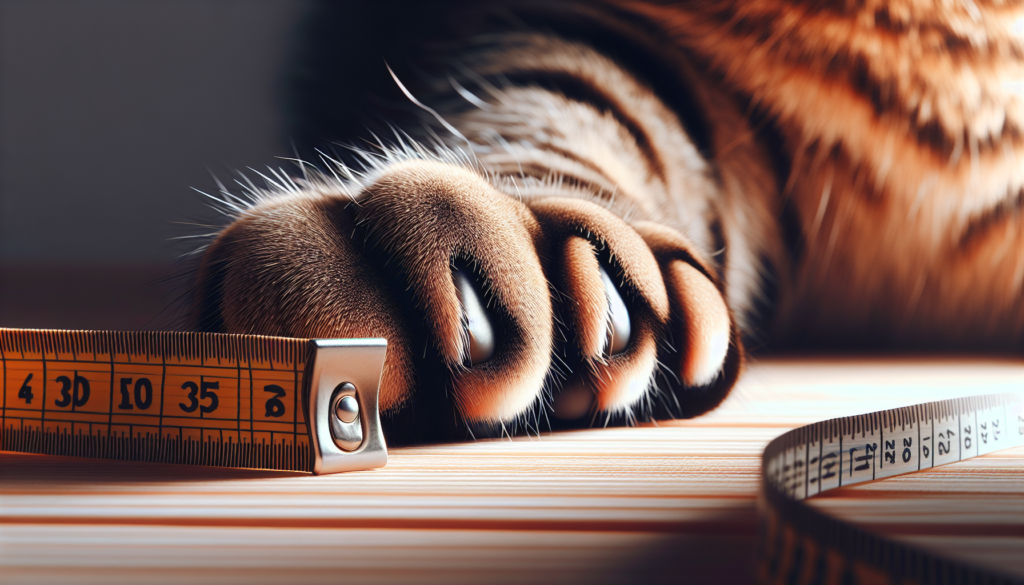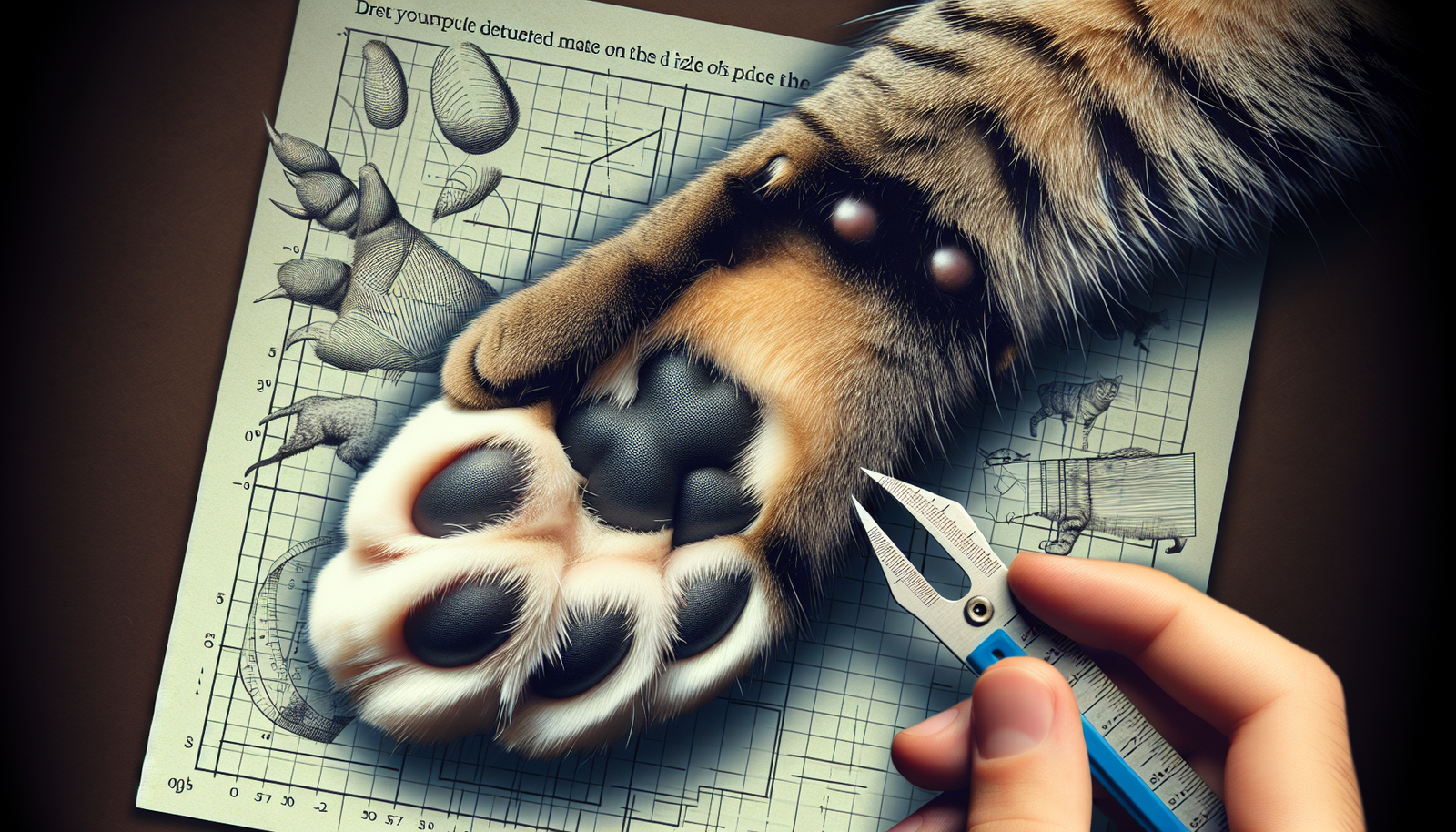So you’re curious about the size of a tabby cat? Well, determining the size of these adorable feline companions can be quite intriguing. Whether you’re a new cat owner or a seasoned enthusiast, understanding the typical size range of tabby cats is essential. In this article, we will explore the various factors that contribute to their size, from genetics to gender, and provide you with valuable insights to help you gauge just how big your tabby friend might become. So, grab a cup of tea and get ready to embark on a journey into the world of tabby cat sizes!
Physical Characteristics
Coat Pattern
Tabby cats are known for their distinctive coat patterns, which typically consist of stripes, swirls, or spots. These patterns can vary greatly from one cat to another, creating a unique and individual appearance. The most common tabby patterns are the classic or “blotched” tabby, mackerel tabby, and the spotted tabby. Each pattern can give the cat a different visual effect, but they all add to the charm and beauty of tabby cats.
Body Shape
In terms of body shape, tabby cats generally have a medium to large build. They have a muscular and athletic build, which contributes to their agility and grace. The body proportions of a tabby cat are well-balanced, with a strong, sturdy frame. However, it’s important to note that there can be variations in body shape within individual tabby cats, just like in any other breed.
Tail Length
The length of a tabby cat’s tail can vary, but it is typically proportionate to their body size. Tabby cats have long, slender tails that are flexible and expressive. A longer tail can give the cat a more elegant and graceful appearance, while a shorter tail may suggest a more compact and sturdy build. However, tail length alone is not a reliable indicator of a tabby cat’s overall size.
Head Size
Tabby cats usually have medium-sized heads with a well-defined jawline. The shape of their heads can vary slightly, with some cats having a more rounded or triangular shape. Their ears are proportionate to their head size and are typically upright and alert. The size of a tabby cat’s head can give a general indication of their overall size, but it should not be solely relied upon for determining their size.
Size and Weight Variations
Average Size
On average, tabby cats are medium to large-sized cats. Male tabby cats tend to be larger than females, but there can still be variations in size within each gender. Adult tabby cats usually range between 8 to 16 pounds in weight, with some individuals falling outside of this range. It’s important to remember that size can also be influenced by factors such as genetics, overall health, and individual growth patterns.
Larger or Smaller Tabby Cats
While most tabby cats fall within the average size range, there can be larger or smaller individuals within the breed. Factors such as genetics, diet, exercise, and overall health can contribute to variations in size. Some tabby cats may naturally be smaller or larger due to their genetic makeup or individual growth patterns. It’s important not to compare a tabby cat’s size solely to other individuals but to consider their overall health and well-being.
Factors Affecting Size
Several factors can influence the size of a tabby cat. Genetics play a significant role in determining a cat’s size, as certain genes can contribute to larger or smaller body frames. Additionally, nutrition and diet can impact a cat’s growth and overall size. Providing a balanced and appropriate diet, suitable for their age and activity level, can help support healthy growth. Environmental factors, such as exercise and living space, can also influence a tabby cat’s size.
Determining Adult Size
It can be challenging to determine the exact adult size of a tabby cat, especially during their early stages of growth. However, observing their growth patterns, considering their genetic background, and consulting with a veterinarian can provide some insight into their potential adult size. The key is to provide proper care, nutrition, and regular veterinary check-ups to support their healthy growth and development.
Measuring a Tabby Cat
Measuring Height
Measuring the height of a tabby cat can be a bit tricky, as they are not usually measured in the same way as humans. A rough estimate can be obtained by observing their shoulder height, which is the highest point of their body when they are standing on all four legs. This can give an indication of their overall height, but it should be noted that height alone is not a reliable indicator of a cat’s size.

Measuring Length
To measure the length of a tabby cat, start from the base of their tail and extend the measuring tape all the way to the tip of their nose. This measurement can give an approximation of their overall length. However, keep in mind that the length alone may not accurately determine a cat’s size, as other factors such as body shape and weight also play a role.
Measuring Weight
Measuring a tabby cat’s weight is one of the most practical ways to determine their size. Using a pet scale or a regular scale designed for weighing cats, hold the cat still and gently place them on the scale. Make sure to take into account the weight of the carrier or any other objects the cat may be on. It’s important to note that weight alone may not provide a complete picture of a cat’s size, as other factors such as body composition and muscle tone should also be considered.
Growth Stages
Kitten Stage
During the kitten stage, tabby cats experience rapid growth and development. They are generally smaller in size and have more delicate features compared to adult cats. The duration of the kitten stage can vary, but it typically lasts until they reach around one year of age. During this phase, it’s crucial to provide proper nutrition, socialization, and veterinary care to support their healthy growth.
Adolescent Stage
The adolescent stage is a transitional period between kittenhood and adulthood. Tabby cats in this stage will continue to grow and develop, although at a slower pace compared to the rapid growth seen in kittens. This stage can last from around one year of age until the cat reaches their full adult size, which is usually between two to three years old. During this period, it’s important to monitor their growth and adjust their diet and exercise accordingly to ensure a smooth transition into adulthood.
Adult Stage
Once a tabby cat reaches their full adult size, they enter the adult stage of their life. Depending on their genetic background and individual growth patterns, this stage generally begins around two to three years of age. Adult tabby cats have reached their mature size and weight, and they typically maintain their physical characteristics throughout their adult life. Regular veterinary check-ups, proper nutrition, and an active lifestyle are essential during this stage to promote a healthy and happy life for your tabby cat.
Comparison with Other Cat Breeds
Size Variation Among Cat Breeds
When comparing tabby cats to other cat breeds, it’s important to consider the wide range of sizes that exist within the feline world. Different cat breeds can vary significantly in size, with some breeds being naturally larger or smaller than others. For example, the Maine Coon breed is known for its large size, often weighing between 12 to 18 pounds or even more in some cases. On the other hand, breeds like the Singapura are much smaller in size, with adult males weighing around 6 to 8 pounds. It’s important to consider these variations when comparing tabby cats to other breeds.
Differentiating Tabby Cats
While tabby cats come in various sizes and coat patterns, it’s their unique combination of characteristics that sets them apart from other breeds. Tabby cats can be found in different cat breeds, such as the American Shorthair, Maine Coon, Bengal, and many others. What distinguishes them as tabby cats is their specific coat pattern, which can have variations within each breed. It’s their charming stripes, swirls, or spots that make them instantly recognizable as a tabby, regardless of their size.
Genetic Factors
Influence of Breed
Genetics play a significant role in determining a cat’s size and physical characteristics, including tabby cats. Different cat breeds have distinct genetic traits that can contribute to variations in size. Breeds like the Maine Coon, known for their large size, often pass down genes that result in bigger body frames. On the other hand, smaller breeds like the Singapura may have genes that contribute to their petite size. Understanding the influence of breed genetics can provide insight into the potential size of a tabby cat.
Influence of Parent Cats
The size of a tabby cat can also be influenced by the size of their parent cats. Just like in humans, genetic inheritance plays a significant role in determining physical characteristics. If both parent cats are on the larger side, their offspring are more likely to be larger as well. However, it’s essential to note that there can still be variations within a litter, meaning not all kittens will inherit the exact size of their parents.

Polygenic Inheritance
Polygenic inheritance refers to the inheritance of traits controlled by multiple genes, rather than a single gene. Size is a polygenic trait, and it can be influenced by a combination of genetic factors. While specific genes may contribute more to size than others, the overall genetic makeup of a tabby cat is complex and can lead to variations in size. It’s important to consider this polygenic inheritance when trying to determine the size of a tabby cat.
Environmental Influence
While genetics play a significant role in determining size, environmental factors can also contribute. Factors such as nutrition, exercise, and living space can impact a cat’s growth and overall size. A well-balanced diet and regular exercise can promote healthy growth, while a sedentary lifestyle or insufficient nutrition may lead to stunted growth in some cases. By providing a nurturing and stimulating environment, you can support your tabby cat’s optimal growth and development.
Visible Indicators of Size
Paw Size
Tabby cats, like most cats, have proportionate paw sizes to their body size. Observing the size and shape of a cat’s paws can give some insight into their overall size. Larger paws may suggest a larger frame and potentially a larger adult size, while smaller paws may indicate a smaller build. However, it’s essential to consider other factors such as body proportions and weight to get a more accurate estimate of a cat’s size.
Ears and Eyes
The size and shape of a tabby cat’s ears and eyes can also provide some clues about their size. Generally, larger ears and eyes can give the impression of a larger cat, while smaller features may suggest a smaller size. However, it’s important to note that the size of a cat’s ears and eyes alone may not accurately determine their overall size. It’s always best to consider multiple indicators when estimating a tabby cat’s size.
Body Proportions
The overall body proportions of a tabby cat can provide insight into their size. A well-balanced cat with a sturdy frame and well-developed muscles may suggest a larger size, while a more delicate build may indicate a smaller size. Observing the cat’s body in relation to their head size and leg length can help form a more accurate impression of their overall size.
Muscle Tone
Muscle tone can also be an indicator of a cat’s size. A well-toned and muscular cat may suggest a larger overall size, while a less muscular build may indicate a smaller size. It’s important to consider the cat’s overall body condition and muscular development when trying to estimate their size. Muscle tone can be influenced by factors such as exercise, diet, and overall health, so it’s essential to provide appropriate care and stimulation to support their physical development.
Veterinary Assistance
Consulting a Veterinarian
If you are unsure about the potential size of your tabby cat, consulting with a veterinarian can provide valuable insights. Veterinarians have experience in assessing and monitoring cat growth, and they can provide guidance tailored to your specific cat’s needs. They can conduct a thorough physical examination, consider your cat’s genetics and growth patterns, and provide expert advice on nutrition and overall care that can support your tabby cat’s healthy growth.
Special Cases
In some cases, there may be underlying health conditions or growth abnormalities that can affect a tabby cat’s size. These cases are relatively rare, but if you have concerns about your cat’s growth or suspect any health issues, it’s essential to seek veterinary assistance. A veterinarian can conduct further examinations, run necessary tests, and provide appropriate treatment to address any health concerns that may impact your cat’s growth.
Estimating Size through Health Checks
Regular health checks with a veterinarian can also give insights into a tabby cat’s potential size. During these appointments, the veterinarian will assess the cat’s overall health, body condition, and growth progress. By monitoring their growth over time, the veterinarian can provide an estimate of their potential adult size based on their observed growth patterns and development. These health checks are essential in ensuring that your tabby cat is growing and developing properly.
Behavioral Cues
Observing Activity Levels
While size alone may not accurately determine a tabby cat’s adult size, observing their activity levels can provide some clues. Larger cats often have more energy and higher activity levels, while smaller cats may be more reserved or have less stamina. However, it’s important to consider that activity levels can also be influenced by factors such as age, health, and temperament. Observing a cat’s behavior in conjunction with other indicators can provide a more comprehensive understanding of their potential size.
Interacting with Other Cats
If you have the opportunity to observe a tabby cat interacting with other cats, you may gain insights into their relative size. Comparing their body size to other cats can give you a general idea of their relative size within a feline group. However, it’s important to remember that size can vary within individual cat breeds, so it’s not always accurate to compare a tabby cat’s size solely to other cats.
Exploring Vertical Spaces
A cat’s inclination to explore vertical spaces can also provide some indications of their potential size. Cats with a larger and more athletic build may be more inclined to climb, jump, and explore higher surfaces. On the other hand, smaller cats may prefer lower areas or have more difficulty navigating vertical spaces. However, it’s important to consider other factors such as age, health, and individual personality when assessing a cat’s behavior in relation to their size.
Record Keeping
Monitoring Growth
Keeping a record of your tabby cat’s growth can be helpful in estimating their size and tracking their development over time. Record their weight, length, and height at regular intervals, such as monthly or quarterly, and note any significant milestones or changes observed during these periods. By comparing these records, you can identify growth patterns and potential deviations that may require attention or further veterinary assessment.
Weighing and Measuring
Regularly weighing and measuring your tabby cat can provide valuable data for estimating their size. Use a pet scale or a regular scale designed for weighing cats to ensure accurate measurements. Note down their weight, length, and height, and keep a log of these measurements. This information can be beneficial in determining their growth rate and potential adult size.
Creating Growth Charts
Creating a growth chart for your tabby cat can help visualize their growth and development. Use a spreadsheet or a dedicated growth chart app to plot their weight, length, and height over time. This visual representation can provide a clear overview of their growth patterns and highlight any notable changes or deviations. Sharing this information with your veterinarian can help them assess your cat’s growth progress and provide appropriate guidance based on the charted data.
In conclusion, determining the size of a tabby cat can be a complex task that requires consideration of multiple factors. While genetic factors, environmental influences, and visible indicators can provide some insight into their potential adult size, it’s important to remember that size alone does not define a cat’s worth or personality. Ultimately, providing proper care, nutrition, and regular veterinary check-ups are key to ensuring your tabby cat’s healthy growth and overall well-being.

